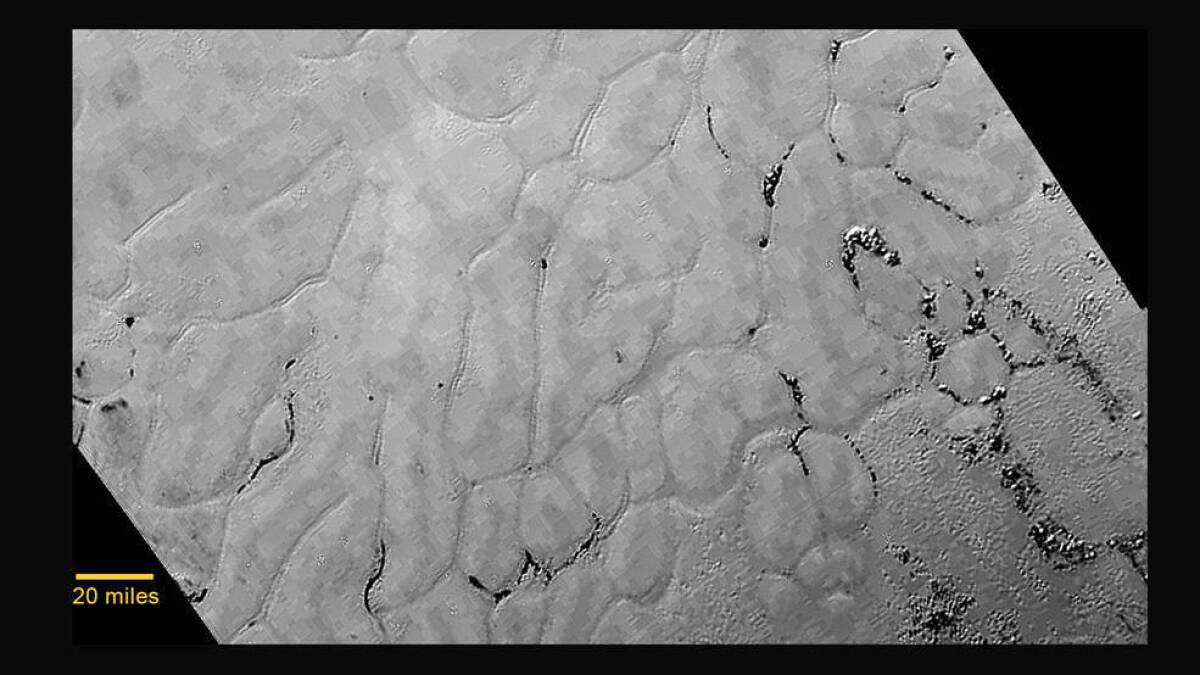Geology on ice: Scientists unveil video of frozen mountains and plains on Pluto

This image of an icy plain on Pluto is notable for its lack of craters. “This could only be a week old, for all we know,” one scientist said.
New images of Pluto sent to Earth by the New Horizons spacecraft are bolstering the case that the dwarf planet is a geologically active world.
Pluto is one of the largest objects in the Kuiper belt, a distant region beyond Neptune made up of frozen relics from the solar system’s early days.
But the lack of impact craters on parts of Pluto’s surface means the planet has been changing in the relatively recent past.
“It couldn’t possibly be more than 100 million years old, and is possibly still being shaped to this day,” said Jeff Moore, leader of the New Horizons Geology, Geophysics and Imaging team at NASA’s Ames Research Center. “It could be only a week old, for all we know.”
The area in question is a newly revealed ice plain in the center of Pluto’s heart region, now known as Tombaugh Regio. Photographed by New Horizons’ Long Range Reconnaissance Imager at a distance of 48,000 miles, it contains a series of smooth polygons about 12 miles in width that are separated from each other by what appear to be shallow troughs.
As seen from above, the lightly creased landscape is reminiscent of elephant skin.
“I saw this image for the first time and decided I was going to call it ‘not-easy-to-explain terrain,’” Moore said Friday.
It will take 16 months for all of the data captured by New Horizons’ instruments to reach scientists on Earth. But the handful of images received so far point to two potential origin stories for the cracked-looking landscape, mission scientists said.
One possibility is that the pattern was created by the contraction of surface materials on the dwarf planet, similar to what happens on Earth when mud dries or when a pot of oatmeal is left on the stove for too long.
Alternatively, these shapes may have been formed by convection processes, the way wax rises up in a lava lamp. If that is the case, the convection would have taken place in a surface layer of the planet. The heat would have come from the planet’s interior.
Toward the southeast of the ice plains are clumps of dark goose-bump-shaped features that Moore identified as hills. Scientists do not yet know their height or composition.
Here, too, a few different origin stories are on the table. Perhaps the hills formed from material that was pushed up through the troughs. Or they could be erosion-resistant knobs that have been left standing on the surface.
The New Horizons team is wary of scientific speculation, especially because the data are so new.
“When we get the data down, we can tell exactly how high they are and their shape, and that will help us understand better what is going on,” Moore said.
The team also identified dark streaks in the western portion of the picture. Moore said these might have been produced by winds blowing across Pluto’s icy surface. It’s even possible that they might be deposits from plumes or geysers, like those seen erupting from the frozen surface of Neptune’s moon Triton.
Moore emphasized that the New Horizons team had not seen plumes or geysers on Pluto. But as more data arrives, the scientists will be looking closely.
“In these early days, we are entertaining the widest ranges of possibilities,” he said. “Jumping to conclusions comes at great peril.”
New Horizons has also sent back initial observations of Pluto’s atmosphere. It is made primarily of nitrogen, just like the atmosphere of Earth, and it is quite expansive, extending 620 miles above the surface of the dwarf planet.
Computer models suggest that the solar wind — a stream of highly charged particles speeding away from the sun — is causing Pluto to lose its atmosphere at the rate of 500 tons per hour. For comparison, the escape rate of Mars’ atmosphere is 1 ton per hour, said New Horizons co-investigator Fran Bagenal, a plasma scientist at the University of Colorado Boulder. Pluto’s atmosphere is expected to escape much faster because it has so little gravity.
If this hypothesis is true, that means Pluto likely has a tail of ionized nitrogen.
The data that would prove this theory have not yet arrived, but Bagenal is the information soon.
“By August we will quantify the escaping atmosphere,” she said.
New Horizons team members also released the first pixelated image of Pluto’s small moon Nix, revealing it is about 25 miles across and has a brightness between those of Pluto and Charon.
Science rules! Follow me @DeborahNetburn and “like” Los Angeles Times Science & Health on Facebook.




